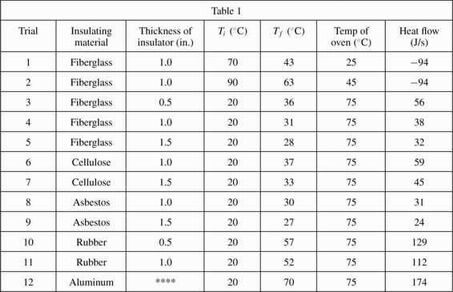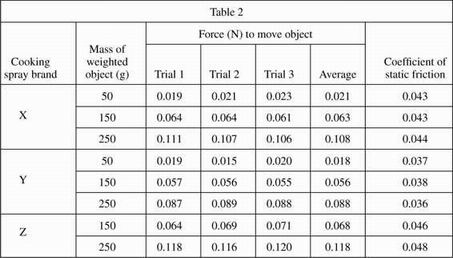
ACT Science Practice Test 48
Đề thi nằm trong bộ sưu tập: Tuyển Tập Bộ Đề Thi Đại Học Hoa Kỳ (ACT) - Có Đáp Án Chi Tiết
Số câu hỏi: 11 câuSố mã đề: 1 đềThời gian: 1 giờ
217,828 lượt xem 16,752 lượt làm bài
Xem trước nội dung:
PASSAGE III
Students conducted an experiment to determine the insulating properties of certain materials. In each trial, "blankets" made of different materials of different thicknesses were wrapped around an aluminum capsule filled with 0.250 L of water at a known initial temperature, Ti, and placed into an oven preheated to a certain temperature. Heat was transferred through the insulating materials from the oven to the water inside the capsule. After 5 minutes, the temperature of the water inside the capsule, Tf, was recorded. The heat flow, measured in joules per second (J/s), is shown in Table 1.

(Note: In each trial, the same size and shape of aluminum capsule were used. One trial was done with no insulation around the aluminum capsule.)
According to the information provided, heat flowed from the water in the capsule at temperature Ti to the surrounding oven in which of the following trials?
Trial 1
Trial 5
Trial 9
Trial 12
The best insulators are those that are the poorest heat conductors. According to Trials 3 through 11, which of the following materials would likely provide the best insulation between a room and the outdoors?
Fiberglass
Cellulose
Asbestos
Rubber
According to Table 1, which of the following combinations of insulating material and insulator thickness resulted in the greatest heat flow?
Fiberglass, 1.5 in
Fiberglass, 1.0 in
Cellulose, 1.5 in
Cellulose, 1.0 in
Materials differ in their thermal conductivity: the higher the thermal conductivity, the greater the heat flow through the corresponding thickness of the insulating material. According to Trials 4 through 11, which of the following statements about relative thermal conductivities is NOT true?
Fiberglass has a higher thermal conductivity value than asbestos.
Rubber has a higher thermal conductivity value than cellulose.
Cellulose has a lower thermal conductivity value than fiberglass.
Fiberglass has a lower thermal conductivity value than rubber.
Trials 3 and 5 provide evidence that heat flow depends on which of the following factors?
Type of insulating material.
Temperature of oven.
Contact area.
Thickness of insulating material.
PASSAGE IV
A group of students conducted several experiments using a variety of nonstick cookware, a spring scale, and several objects with different mass. Their goal was to determine which brand of cookware products had the best nonstick surface by measuring the coefficient of static friction, which is a measure of how resistant a stationary object is to movement.
Experiment 1
A student connected the spring scale to a weighted object that was placed inside a piece of nonstick cookware as shown in Figure 1.

Figure 1
The students planned to calculate the coefficient of static friction by determining the force required to disturb an object from rest. During the experiment, one student anchored the nonstick cookware by holding tightly to the handle while the other student attached a weighted, smooth steel object to the spring scale. The student pulled on the spring until the object began to move. A third student recorded the force in newtons, N, indicated on the spring scale at the moment the object began to move across the nonstick surface.
This procedure was repeated for 3 different brands of cookware; each brand of cookware was tested with various weighted objects. The coefficient of static friction was calculated and the results are shown in Table 1.

Experiment 2
The students performed an experiment similar to Experiment 1, except three different brands of cooking spray were applied to the same cookware surface before the weights were put in place. The results are shown in Table 2.

The results of the 2 experiments support the conclusion that as the mass of an object increases, the average force required to move it from rest generally:
decreases.
increases.
varies, with no particular trend.
remains constant.
If Experiment 1 was repeated for Brand B cookware with a 200 gram object, the average force needed to disturb the object from rest would be closest to:
0.03
0.06
0.12
0.18
Based on the results of Experiments 1 and 2, which of the following combinations would result in the surface with the least coefficient of static friction?
Cookware brand A and cooking spray brand
Cookware brand B and cooking spray brand
Cookware brand C and cooking spray brand
Cookware brand C and cooking spray brand
Which brand(s) of cooking spray was/were tested with only 2 different objects in Experiment 2?
Brand Y only.
Brand Z only.
Brands X and Y only.
Brands X and Z only.
According to the passage, for the students to accurately measure the coefficient of static friction, which force would have to be overcome?
The weight of the object.
The force between the spring scale and the object.
The force of applying the cooking spray to the surface.
The force required to disturb the object from rest.
The students' instructor gave them one piece of nonstick cookware and asked them to identify the brand. The students repeated the procedures followed in Experiment 1 and obtained average forces of 0.088 N for the 150 gram object and 0.149 N for the 250 gram object. Which of the following brands would most likely have produced these results?
Brand B only.
Brand C only.
Brand A and C only.
Brand B and C only.
